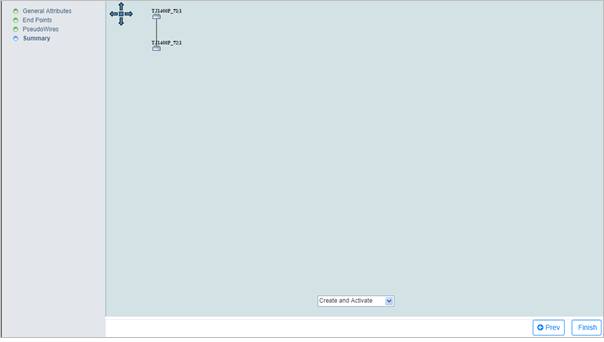Multiprotocol Label Switching (MPLS) is a standards-approved technology for speeding up network traffic flow and making it easier to manage. MPLS involves setting up a specific path for a given sequence of packets, identified by a label put in each packet, thus saving the time needed for a router to look up the address to the next node to forward the packet.
Perform the following steps to create a new service in MPLS-TP domain:
NOTE: Before creating a MPLS-TP service, create MPLS tunnel on NNIs and set the UNI ports to 'VLAN only' or 'VLAN+PRIO' or 'VLAN+DSCP'.
> To create an ELINE service, select the Service Type as ELINE.
> To create an ELAN service, select the Service Type as ELAN. For more information, refer to the topic Create ELAN services with full mesh for creating an ELAN service of Full Mesh type and topic Create ELAN services with Hub and Spoke for ELAN Hub and Spokes service.
> To create the service in Non Qos Domain, select the Domain as Non Qos Domain.
> To create the service in Qos Domain, select the Domain as Qos Domain.
> To create the service in any of the two domain, select the Domain as All Domain.
> To disable OAM on the service, select OAM as None from drop-down option.
> To enable OAM on the service, select OAM as BFD Config. Select BFD Configuration parameters displayed.
> To enable PWSM on the service, select OAM as Pw Status. Select PW Status Configuration parameters displayed.
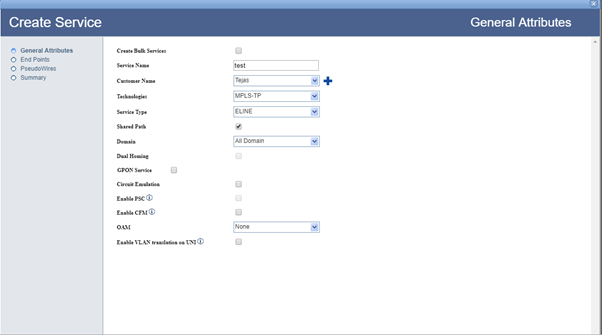
General Attributes parameters
Parameter |
Description |
Default Value |
Acceptable Values |
|---|---|---|---|
Service Name |
Enter a name for the service. Service name should begin with an alphabet. |
Default Service |
|
Customer Name |
Select the name of the customer from the options available in drop down list; or to create a new customer, click |
custName |
|
Technologies |
Select the type of technology as 'MPLS-TP' for service creation. |
MPLS-TP |
MPLS-TP |
Service Type |
Select the type of service to be created. |
ELINE |
|
Shared Path |
Select the check box if the service being created is desired to be shared with different customers. |
-- |
-- |
Mesh |
Select the option from the drop down menu as 'Full mesh' or 'Hub and Spoke'. |
Full Mesh |
|
Domain |
Select the domain for the service being created. |
Qos Domain |
|
Dual Homing |
Select the check box to create a Dual Homed Service. NOTE: On selecting Dual Homing check box, Backup Nodes is added to steps of service creation on left panel of the General Attributes window. |
-- |
-- |
GPON Service |
Not applicable. |
-- |
-- |
Circuit Emulation |
Select the check box to configure a CEM service. NOTE: On selecting Circuit Emulation check box, Configure CESIWF is added to steps of service creation on left panel of the General Attributes window. |
-- |
-- |
Capacity |
Select the capacity from the drop down menu. |
E1/DS1 |
|
CESIWF Count |
Enter the value for the number of CESIWFs to be created. |
1 |
Number of CESIWFs to be created. |
Enable PSC |
Select the check box to enable Protection State Coordination. On selection, OAM by default is set as BFD Config. |
-- |
-- |
Enable CFM |
Select the check box to enable Connectivity Fault Management (CFM). NOTE: On selecting Enable CFM check box, Advance Configuration and CFM Configuration are added to steps of service creation on left panel of the General Attributes window. |
-- |
-- |
OAM |
Select the desired option from the drop down list to enable or disable OAM on the service.
|
BFD Config |
|
Enable VT on UNI |
Select the check box to enable VLAN Translation (VT) feature on UNI. It is not applicable CEM services. NOTE: On selecting the check box, VT ON UNI Configuration is added to steps of service creation on left panel of the General Attributes window. |
-- |
-- |
PW Status/BFD Configuration |
|||
Pw Status refresh Time |
Enter the refresh time for pseudowire status message. This parameter is displayed when OAM is set as Pw Status. |
600 |
1 to 65535 second |
CC |
Enable the check box to verify the connectivity between two MEPs at regular intervals. |
||
CCM Interval |
Select the continuity check message time interval from the drop down list. This parameter is displayed when OAM is set as BFD Config. |
100 ms |
|
Y1731 Mode |
Standard defining OAM functions and mechanisms for Ethernet based networks. Allows the user to enable or disable performance monitoring. |
Disable |
|
Maintenance Domain |
Select the maintenance domain level from the options available in drop down list; or to create a new maintenance domain, click |
-- |
-- |
Revertive |
Traffic is automatically switched back to the work path after the WTR time, when the fault is rectified. Select the check box as desired. |
-- |
-- |
WTR |
Select the required wait-to-time restore from the drop down list. |
5 |
5 to 12 minutes |
Advanced QoS Configuration |
Select the check box to enable CIR parameter for QoS configuration. |
||
SRLG Disjoint |
Select the check box to ensure that the work and protect paths selected are mutually link SRLG disjoint. The check box will be selected by default. |
-- |
-- |
There are two ways of searching the desired node from the list explained as follows:
> Enter the IP address/user label of the node in the text box provided and click ![]() (Search Node by IP Address or UserLabel). Or,
(Search Node by IP Address or UserLabel). Or,
> Click ![]() (Add switches using map view) and select desired NEs from the Topology selection window launched. Click Done. Note that only one node can be added at a time.
(Add switches using map view) and select desired NEs from the Topology selection window launched. Click Done. Note that only one node can be added at a time.
> If Domain is selected as 'Non Qos Domain' or All Domain' on General Attributes page, enter the VLAN value only. For All Domain the UNI port can be associated with TCProfile and CoS-0.
> If Domain is selected as 'Qos Domain', enter the VLAN value and associate a Priority Mapping Profile or DSCP Mapping Profile or a pair of TCProfile and COS values.
To view the bandwidth utilization, click View BW. View Port BW Utilization window is displayed with the bandwidth utilization details of Ingress and Egress Port.
To view the used VLAN range, click Show Used VLans. View Used VLAN Range(s) window is displayed with a list of used VLAN values for the selected port.
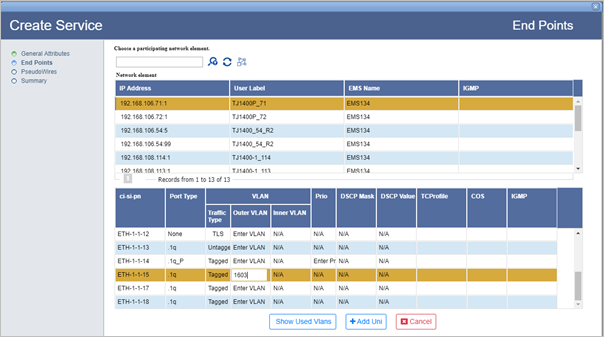
An ELine service must have two end points as shown in the following figure:
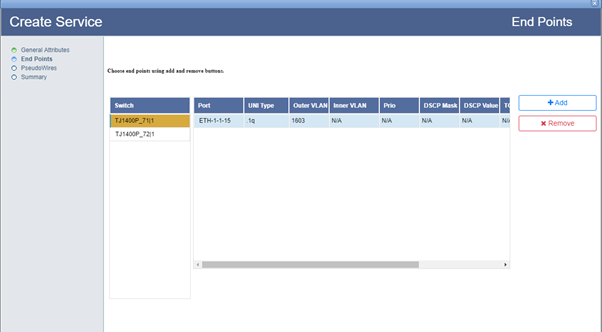
End Points parameters
Parameter |
Description |
|
|---|---|---|
Choose a participating network element. |
||
|
Search Node by IP Address or UserLabel button allows you to search the node from the network element list. Enter the IP address or user label of the desired node in the text box provided and click this button. |
|
|
Load all nodes button reloads all the nodes in network element list. |
|
|
Add switches using map view button allows you to select the switches from the topology selection window. |
|
Network element |
||
IP Address |
Displays the IP address of the node. |
|
User Label |
Displays the node label. |
|
EmsName |
Displays the EMS name in which the given node is present. |
|
IGMP |
Parameter not applicable. |
|
ci-si-pn |
Displays the shelf index, slot index and port number. |
|
Port Type |
Displays the port type. |
|
VLAN |
Traffic Type |
Select the traffic type as 'Tagged' or 'Untagged' or 'TLS'. |
Outer VLAN |
Enter the VLAN ID. Acceptable value range from 1 to 4094 or 1 to 212 -1. |
|
Inner VLAN |
This is applicable when VLAN type of Port is .1ad with .1q. Then .1q VLAN is inner VLAN and .1ad VLAN is outer VLAN. Acceptable value range from 1 to 4094 or 1 to 212 -1. |
|
Prio |
Displays the priority for VLAN+PRIO port. |
|
DSCP Mask |
The mask assigned for Differentiated Services Code Point (DSCP) field for VLAN+DSCP port. |
|
DSCP Value |
The Differentiated Services Code Point (DSCP) value defined for DEI bit for VLAN+DSCP port. |
|
TCProfile |
Allows to select the TCProfile created at the NMS level. Acceptable values includes a list of TC Profiles created. |
|
COS |
Allows to select an identifier for the default CoS queue to which the packet is assigned. Acceptable value ranges from 0 to 7. |
|
Priority Mapping Profile |
Allows you to associate a priority mapping profile to the selected port from the drop down list. |
|
DSCP Mapping Profile |
Allows you to associate a DSCP mapping profile to the selected port from the drop down list. |
|
IGMP |
This parameter is not applicable. |
|
L2 ACL |
This parameter is not applicable. |
|
Choose end points using add and remove buttons. |
||
Switch |
Displays the switch IP address of the selected node. |
|
Port |
Displays the UNI port selected for creation of end points. |
|
UNI Type |
Displays the type of switching protocol of the user network interface. |
|
Outer VLAN |
Displays the selected VLAN ID. |
|
Inner VLAN |
This is applicable when VLAN type of Port is .1ad with .1q. Then .1q VLAN is inner VLAN and .1ad VLAN is outer VLAN. |
|
Prio |
Displays the priority. |
|
DSCP Mask |
The mask assigned for Differentiated Services Code Point (DSCP) field. Parameter not applicable, hence displays N/A. |
|
DSCP Value |
The Differentiated Services Code Point (DSCP) value defined for DEI bit. |
|
TCProfile |
Displays the TCProfile selected for the UNI port created at the NMS, if any; else N/A is displayed. |
|
COS |
Displays the selected identifier for the default CoS queue to which the packet is assigned. |
|
Priority Profile |
Displays the priority mapping profile associated with the UNI port, if any; else N/A is displayed. |
|
DSCP Mapping Profile |
Displays the DSCP mapping profile associated with the UNI port, if any; else N/A is displayed. |
|
Igmp Profile |
Displays the IGMP mapping profile associated with the UNI port, if any; else N/A is displayed. |
|
L2 ACL |
This parameter is not applicable. |
|
Add |
Add end point button allows the user to add nodes for the creation of end points. |
|
Remove |
Remove selected end point button allows the user to remove the selected node chosen for end points creation. |
|
The VT ON UNI Configuration step is displayed only if 'Enable VT on UNI' is selected in General Attributes.
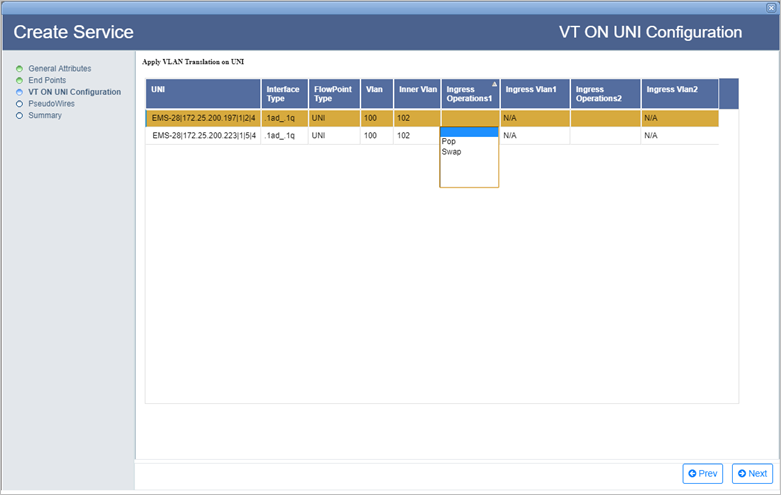
VT on UNI Configuration parameters
Parameter |
Description |
|---|---|
UNI |
Displays the EMS and node information in which UNI is present. |
Interface Type |
Displays the interface type of the UNI as .1q or .1ad or .1ad_.1q. |
Flowpoint Type |
Displays the flow point type as UNI or NNI. It is always UNI. |
Vlan |
Displays the outer Vlan value of the interfaces, entered while adding end points. |
Inner Vlan |
Displays the inner Vlan value of the interfaces, entered while adding end points. It displays as N/A (Not applicable) for .1q interfaces. |
Ingress Operations1 |
Double click and select the option from drop down.
|
Ingress Vlan1 |
This parameter is applicable for Ingress Operations1 selected as Swap. Acceptable value is an integer from 1 to 4094. |
Ingress Operations2 |
This parameter is applicable only to .1ad or .1ad_.1q interfaces. Double click and select the option from drop down.
|
Ingress Vlan2 |
This parameter is applicable for Ingress Operations1 selected as Swap. Acceptable value is an integer from 1 to 4094. |
The PseudoWires page of Create Service provides options to add or remove protection, selection of pseudowire path manually or automatic path detection, and MA configuration.
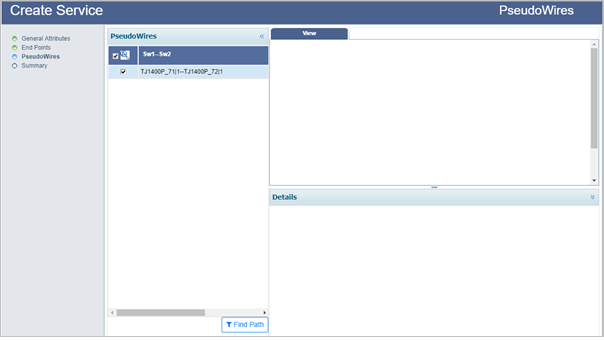
To find path for the pseudowire automatically, do the following steps:
Graphical representation of the pseudowire detected automatically is displayed under the View tab as shown in the following figure. Details of work path, excluded switches and excluded tunnels is available under Details:
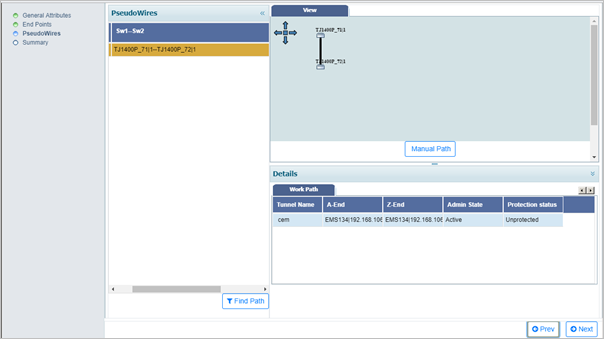
NOTE: When finding the pseudowire path automatically, the user is provided an option to exclude switches/tunnels. Select Excluded Switches and Excluded Tunnels tab. Click Add button and select the desired nodes and/links. Click Exclude Nodes or Exclude Links followed by Done. Remove button can be used to delete the added data. Select Find Path. Pseudowire path is calculated once again, excluding the selected switches/tunnels in the path.
To find path for the pseudowire manually, do the following steps:
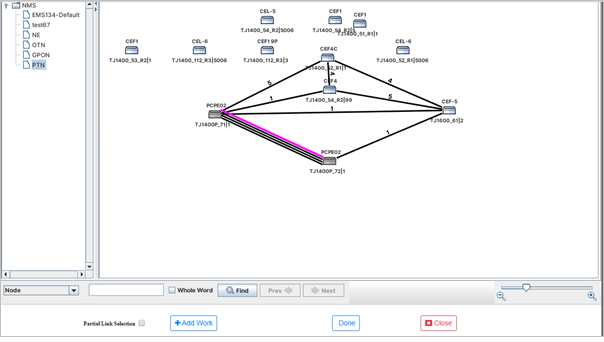
(i) Direct Path Selection: This option is used for direct path selection between two end points with no intermediate nodes in between.
Select a direct path/link between the two selected end points (highlighted in black) and click Add Work. The pseudowire path is added and the link color changes from pink to blue. To add protection (if ![]() (Protection) check box was checked), select another path/link and click Add Protect. Click Done.
(Protection) check box was checked), select another path/link and click Add Protect. Click Done.
The graphical representation of the pseudowire added is displayed on the PseudoWires page under View tab along with work and/ protect path details under Details column as shown in the following figure:
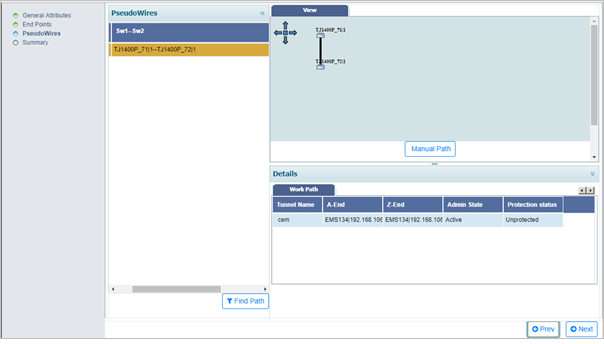
(ii) Partial Link Selection: This option is used when the user has to add more than one link to create a pseudowire path between the two end points.
Select the Partial Link Selection check box. Select the paths/links between intermediate node connecting the two selected end points using CTRL button and click Add Links. The paths/links gets highlighted in cyan color. Click Add Work. The pseudowire path is added and the link color changes from cyan to blue. To add protection (if ![]() (Protection) check box was checked), select Partial Link Selection check box again (if desired) and select another path/link. Click Add Links > Add Protect. Click Done. If path addition fails, the partial link selection will be reset.
(Protection) check box was checked), select Partial Link Selection check box again (if desired) and select another path/link. Click Add Links > Add Protect. Click Done. If path addition fails, the partial link selection will be reset.
Graphical representation of the pseudowire added is displayed on the PseudoWires page under View tab along with work path details under Details column as shown in the following figure:
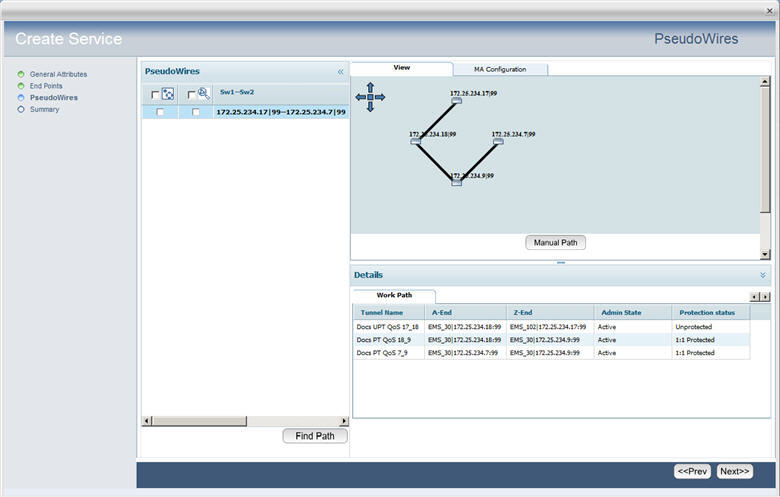
NOTE: An additional PW Status Info page will be displayed if OAM was selected as 'Pw Status' on General Attributes page. For more information refer to Step 4: PW Status Info in the topic Create MPLS-TP service with PWSM.
Advance Configuration window is displayed when Enable LLF check box is selected in the General Attributes page. Enter the values against the desired attributes and click Next.
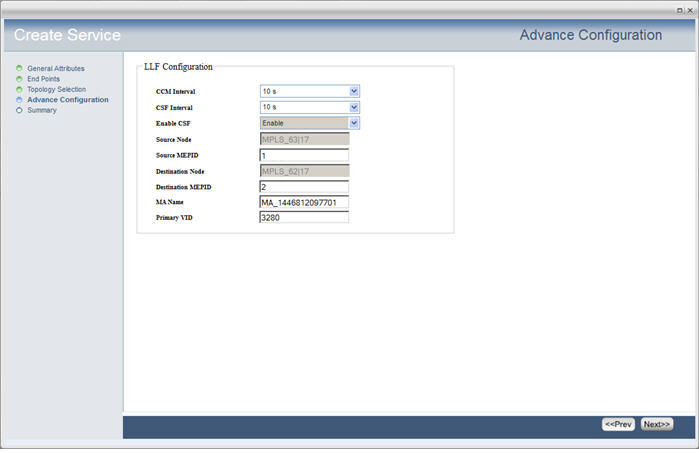
NOTE: An error will be displayed if LLF is not supported on the source and destination nodes.
Advance Configuration window displayed when the Service Type is selected as 'ELAN' in the General Attributes page. To enable, select Enable Broadcast/MultiCast Storm Control check box and enter the BroadCast/Multicast Stormcontrol value in Mbps. The minimum value is 66Kbps.
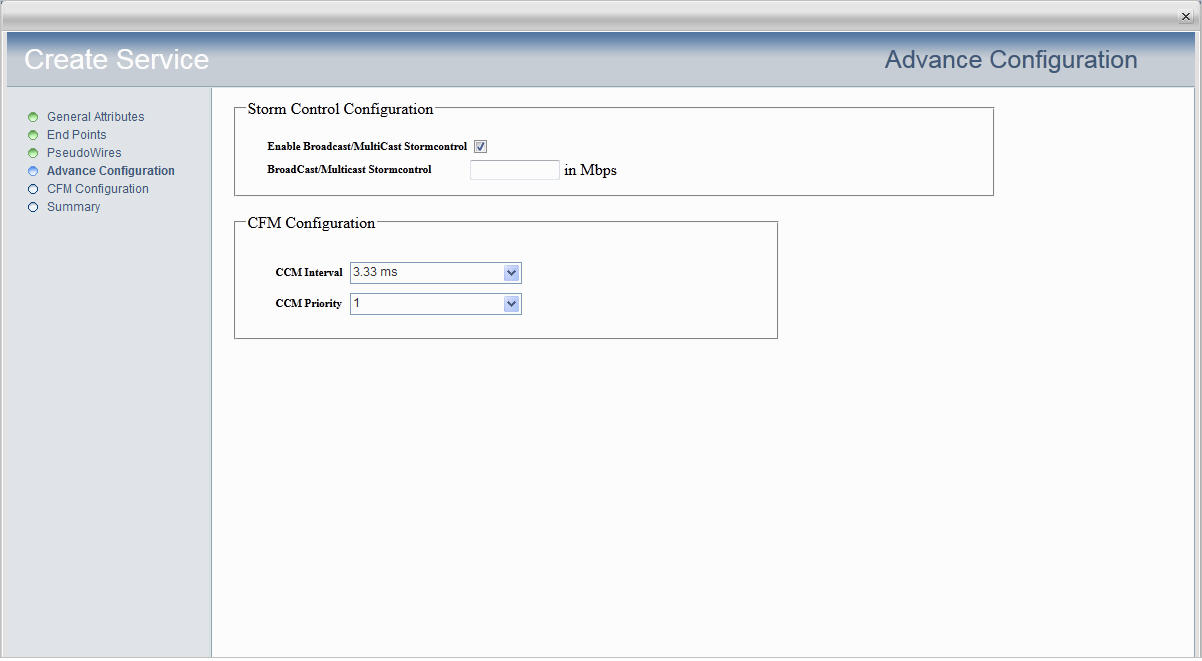
Click Next to view the summary of the service created.
On CFM Configuration page of Create Service the MEP configuration window is displayed as shown in the following figure:
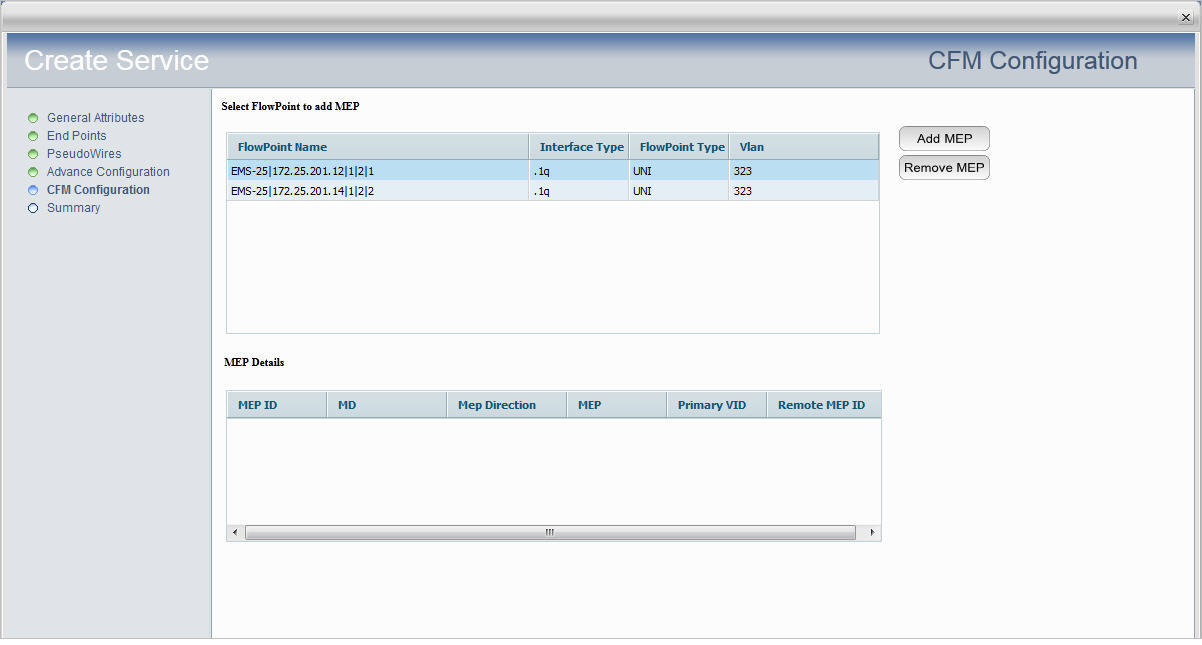
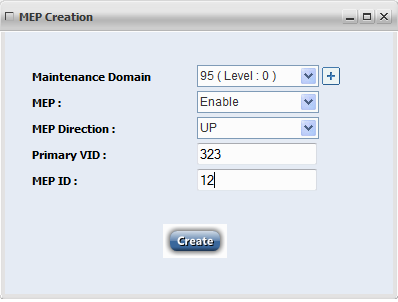
On Summary page of Create Service, the end points with the connecting pseudowire is displayed as shown in the following figure. Work path is represented in solid line while protect as dashed line:
